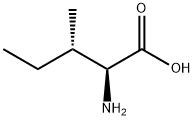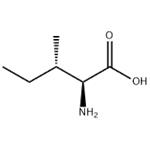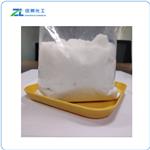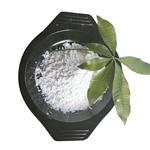Crystalline leaflets or a white, crystalline powder having a bitter
taste. It is soluble in 25 parts of water, slightly soluble in hot
alcohol, and soluble in diluted mineral acids and in alkaline solutions. It sublimes at between 168°C and 170°C, and melts with
decomposition at about 284°C. The pH of a 1 in 100 solution is
between 5.5 and 7.0.
Absolute: The absolute is prepared by alcoholic extraction of the
concrete in approximately 55 to 60% yields. The absolute consists
of a semisolid, olive-green mass with a characteristic ambergris
odor.
Resinoid and Resin Absolute: The resinoid consists of the hydro carbon extract of the crude resin. The resin absolute consists of
the alcoholic extract of the crude labdanum resin. Since this prod uct is a semisolid, nonpourable mass, a high-boiling, odorless
solvent may be added prior to evaporation of the alcohol to prepare
a pourable liquid.
L-Isoleucine may be used as a pharmaceutical reference standard for the quantification of the analyte in pharmaceutical formulations using high-performance liquid chromatography technique.
L-Isoleucine, also known as Isoleucine, is an amino acid that is an isomer of leucine. It is important in hemoglobin synthesis and regulation of blood sugar and energy levels.
L-Isoleucine is one of the essential amino acids that cannot be made by the body and is known for its ability to help endurance and assist in the repair and rebuilding of muscle. This amino acid is important to body builders as it helps boost energy and helps the body recover from training.
L-Isoleucine is also classified as a branched-chain amino acid (BCAA). There are three branched-chain amino acids in the body, with the others being L-Valine, and L-Leucine, and all of them help promote muscle recovery after exercise. Isoleucine is actually broken down for energy within the muscle tissue.
L-Isoleucine acts as an essential amino acid in human. It is used as a flavoring agent and nutritional supplement for foods. It is also used as an antipsychotic. It is employed as a component of proteins. Further, it stimulates immune function and promotes secretion of several hormones. In addition to this, it is used for hemoglobin formation and regulating blood sugar and energy levels.
An advantageous fermentation method for production of L-isoleucine is the use of chemically synthesized substrates that only require a few steps to be converted to L-isoleucine. Among these the natural precursors 2-ketobutyrate or D,L-2-hydroxybutyrate have been used for the production with Corynebacterium glutamicum. A leucine requiring mutant of Corynebacterium glutamicum, with increased D-lactate utilization and consuming D,L-2-hydroxybutyrate, accumulates 13.4 g/L L-isoleucine. However, exploitation of this process is hampered by formation of byproducts. Sugar based L-isoleucine processes have been developed with strains of Corynebacterium glutamicum Serratia marcescens, and Escherichia coli. The mutant Escherichia coli H- 8285, being resistant to thiaisoleucine, arginine hydroxamate, and D,L-ethionine accumulates 26 g/L L-isoleucine in 45 h in a fed-batch process. Introduction of resistance to 6-dimethylaminopurine in strain H-8285 resulted in a mutant Escherichia coli H-8461 that increased L-isoleucine accumulation to 30.2 g/L. The biosynthesis of L-isoleucine has been investigated in detail on the level of involved genes, thus recombinant strains are being constructed with high productivity and selectivity. An appropriate balance of homoserine dehydrogenase and threonine dehydratase activities in the construct Corynebacterium glutamicum DR17/pECM3::ilvA (V323A) with feedback-resistant aspartate kinase create a specific productivity of 0.052 g L-isoleucine per gram dry biomass per hour. The recombinant strain Escherichia coli AJ13100 produces L-isoleucine from glucose with high selectivity in 30% yield.
ChEBI: The L-enantiomer of isoleucine.
L-Isoleucine is an isomer of L-leucine and is an essential amino acid. It is synthesized from threonine and is a branched-chain hydrophobic amino acid.
L-Isoleucine is generally considered a safe ingredient. The side effects may: Intake of Isoleucine can lead to nausea. Large doses can result in a stomach upset and indigestion.
L-Isoleucine is an essential amino acid, which means that humans cannot synthesize it, so it must be ingested. It appears as a white crystalline powder. Foods that have high amounts of L-Isoleucineinclude eggs, soy protein, seaweed, turkey, chicken, lamb, cheese, and fish. This product is often used as a food additive and nutrient in dietary supplements.
Crystallise L-isoleucine from H2O by addition of 4 volumes of EtOH or from aqueous MeOH. It sublimes at 170-181o/0.3mm with 99.7% recovery, unracemised [Gross & Gradsky J Am Chem Soc 77 1678 1955]. [Greenstein & Winitz The Chemistry of the Amino Acids J. Wiley, Vol 1 p 183-191, Vol 3 pp 2043-2073 1961, Huffman & Ingersoll J Am Chem Soc 73 3366 1951, Beilstein 4 IV 2775.]



